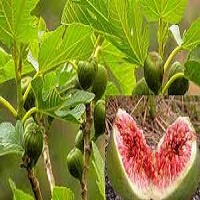Figs are popularly known as “Anjeer” in India, and it is delicious fruit. This fruit is the most ancient in the world. The fig is a unique fruit, unlike most’ fruits’ in which the structure is mature ovary tissue, and the edible structure of the fig is a stem tissue. Figs belong to the family of “Moraceae” and farmers grow them best in regions where hot and long summers are possible. However, they can also grow best in containers. You can eat fresh fig fruit from the tree, preserved and used in cooking. Fig fruits are also known as minor fruit crops. Commercial edible figs cultivation are usually confined to Maharashtra, Gujarat, Uttar Pradesh, Tamil Nadu, and Karnataka. Fig farming is one of the best ways t
Fig and almost all farming require equipment, which plays a significant role in agriculture processing. Therefore, tools, harvesters and tractors are the main ones in the cultivation of fig. Hence, we suggest the Powertrac Tractor, which is better for increasing efficiency in farming.
How to Start Fig Farming in India?
Here we are describing the fig cultivation process with complete specifications.
Varieties of Fig Fruit

There are about 20 most popular varieties of figs being grow globally. Popular figs grown in different countries are White Adriatic, Kodota, Black Mission, Kalamon, Konadira, and Sultani. Poona is the most popular variety cultivation in India for fresh fruit consumption. Farmers mostly grow the figs in Lucknow, Daulatabad, Mangalore, Ganjam, Coimbatore, Bellary, and Saharanpur bear Poona figs. In recent times, a variety named ‘Dinkar’ is an improvement over the ‘Daulatabad’ variety in terms of yield and fruit quality.
Fig Farming – Climate Requirement
Being a deciduous and subtropical fruit tree, the fig prefers areas with high summer temperatures, plenty of sunlight, and moderate irrigation. The quality of fig fruit deteriorates above 39 °C, even though the fig tree survives up to 45 °C. Farmers grow best the fig tree when the temperature is between 15°C to 21°C. The size, shape, colour and quality of the skin are affected by climate. But at the time of fig fruit development and maturity stage, you can obtain quality figs in areas with hot, dry climates. Low temperature and high humidity conditions result in fruit cracking and reduced quality.
Fig Farming – Soil Requirement
Fig crop is one of the most salt and drought-tolerant crops and also it can tolerate fairly high levels of sulphate or chloride salt. For fig cultivation, soil having a pH value of 7 to 8, well-drained, calcareous and medium to heavy are suitable.
Fig Farming – Propagation
You can propagate the fig through cutting. Cuttings of about 25 cm in length with 3 to 6 knots from the previous season should use as planting material.
Fig Farming – Planting
You should usually plant fig trees in a square system @ spacing of 5 m x 5 m accommodating about 150 plants/acre. Then, you should dig the pits for planting the fig tree cutting. The ideal planting season for fig cultivation is June to September.
Fig Farming – Irrigation
Figs have the ability to withstand hot and dry conditions. For commercial cultivation, fig orchards require irrigation. Irrigation at an interval of 3 – 4 days is essential during summers. You should also consider drip irrigation for the best production of figs. 15 to 20 litres of water/day/fig plant is recommended.
Fig Farming – Pests and Diseases
The major pests of fig planting are stem borers, leaf pickers and fig flies. You can control fig fly by using Demacron (0.05% spray). Farmers can control the stem borer by applying phorate granules with petrol or kerosene. The main disease found in fig cultivation is rust and can control by spraying blitox or dusting with sulphur or Dithane M-45 and Dithane Z-78.
Harvesting of Fig Fruit
Fig trees generally start bearing fruit from the second year onwards, and commercial harvesting can be done from the third year. The fruit yield increases with the increase in the size of the tree’s canopy and stabilises during the 8th year. The lifespan of a fig plant is about 30 to 35 years. The harvesting season starts from February to March and ends from May to June. You should harvest the fig fruits manually in 2 to 3 intervals.
Types of Fig or
Anjeer
Four types of fig fruits are available that is based on the method of pollination and sex of the fig flower.
1. Common Figs or Edible Figs:-
Individual flowers are long-styled pistillate, and these fruits develop parthenocarpically. Popular varieties of figs are – Poona, Concordia, Kadota, Mission & Brown Turkey.
2. Capri Figs or Wild Figs:-
These types are functional staminate flowers and small stylize pistil flowers. Capri figs are not edible but you can grow it because they shelter fig wasps (Blastophaga penneus), which are essential for pollination and fruit.
3. Smyrna Figs:-
Fig fruits develop only upon pollination by the male flowers of the Capri fig through the fig wasp. The most important variety is ‘Calimyrna’.
4. San Pedro Figs:-
These are intermediate figs where the crop is parthenocarpic, while the second crop requires pollination like the Smyrna type.
Along with fig farming process information, you should also consider the better equipment in farming, so choose such a tractor that is effective in agriculture. So you can choose the Digitrac Tractor as the best tractor. Likewise, you can also choose the Mahindra tractor and many more.
For more information regarding fig fruit farming in India, stay tuned with us.


No comments yet